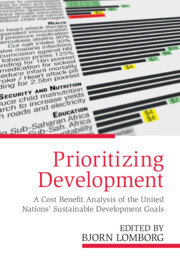 Prioritizing Development
Prioritizing Development Published online by Cambridge University Press: 30 May 2018
My purpose in this perspective is to estimate benefit-cost ratios for the various targets proposed by Fearon and Hoeffler. I estimate most of the targets to be in the Fair to Good range. The authors have done a remarkable job in cataloging various forms of violence, their costs, and the benefits of existing programs. However, one notable weakness is the inability to provide systematic BCRs.
If I could obtain estimates of the benefits of reduced violence, the cost of aid, and the elasticity of aid effectiveness on violence, I could estimate the various BCRs, but this is not a simple task. The authors’ reluctance to follow this route is understandable because such an exercise may be highly speculative.
Fearon and Hoeffler's estimates of the benefits of a world without violence – 11.9 percent of GDP for low- and middle-income countries – are consistent with what one might expect. I assume that the elasticity of aid effectiveness is similar to that for other areas, reducing poverty and encouraging growth and development, for example. The typical estimate of elasticity is 0.01, but I use both this and a more recent, but still small, estimate of 0.03.
The costs of violence differ dramatically with its type and the region. The welfare costs are largest for child abuse and female violence by intimate partners. Latin America and the Caribbean, the Middle East and North Africa, and sub-Saharan Africa are the areas with the greatest potential for benefits.
The ratio of the cost of aid to the potential benefits is significantly large. Using the authors’ measures, the ratio is greater than 30 on average and is as large as 110 in Europe and Central Asia. It is smaller in sub-Saharan Africa and other regions because there is such a significant commitment to aid in these regions. Using the elasticities from the literature, the BCRs fall below 1 for measures to curb violence on a global basis. However, individual regions fare better, particularly Europe and Central Asia and the Middle East and North Africa, where the estimates are between 1 and 3 (Fair).
To save this book to your Kindle, first ensure no-reply@cambridge.org is added to your Approved Personal Document E-mail List under your Personal Document Settings on the Manage Your Content and Devices page of your Amazon account. Then enter the ‘name’ part of your Kindle email address below. Find out more about saving to your Kindle.
Note you can select to save to either the @free.kindle.com or @kindle.com variations. ‘@free.kindle.com’ emails are free but can only be saved to your device when it is connected to wi-fi. ‘@kindle.com’ emails can be delivered even when you are not connected to wi-fi, but note that service fees apply.
Find out more about the Kindle Personal Document Service.
To save content items to your account, please confirm that you agree to abide by our usage policies. If this is the first time you use this feature, you will be asked to authorise Cambridge Core to connect with your account. Find out more about saving content to Dropbox.
To save content items to your account, please confirm that you agree to abide by our usage policies. If this is the first time you use this feature, you will be asked to authorise Cambridge Core to connect with your account. Find out more about saving content to Google Drive.